This series features cats in art. Cats have been depicted in paintings and drawings by both unknown and famous artists throughout time. This series begins in 1400 BC through to 1997 AD.
This is part 1 of 5-part series on Cats in Art:
 |
| 1400 BC from the Tomb of Nebamun at Thebes |
 |
| c1185 The Worksop Bestiary aka the Morgan Bestiary © Morgan Library & Museum, New York City |
 |
| c1225-50 The Medieval Bestiary Bodleian Library, University of Oxford, UK |
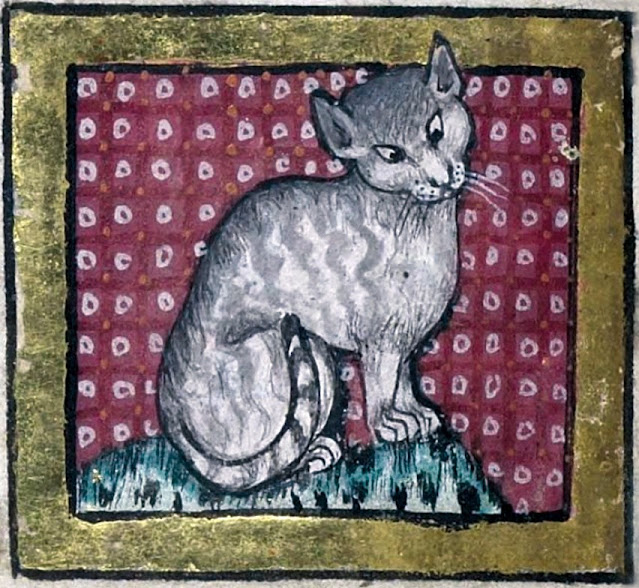 |
| c1300 Cat detail from Peterborough Psalter and Bestiary |
It is called the Peterborough Psalter and Bestiary because the Psalter was adapted for the use of of that abbey, at which time the chronicle was added. The Bestiary, which has been cut down to match the page size of the Psalter, was probably added to the book at some later date. The dating of the Bestiary to c. 1300-10 is earlier by a decade or so than that of the Psalter which is considered to be of c. 1310-20. Both are elaborately illuminated but by quite different artists.
 |
| 1320 Cat & Mouse from the Luttrell Psalter (British Library) |
 |
| c1478-81 Madonna of the Cat by Leonardo da Vinci (1452-1519) pen and brown ink |
 |
| 1478-81c Madonna of the Cat by Leonardo da Vinci (1452-1519) pen and brown ink, on a preparatory drawing in stylus, with a brown wash 13 x 9.4 cm The British Museum, London |
 |
| c1525 Portrait of a woman holding a cat by Francesco Bacchiacca (Francesco d'Ubertino Verdi) (1494-1557) oil on wood panel 26 x 18.5 cm Gemäldegalerie, Berlin |
Francesco Bacchiacca was an Italian painter of the Renaissance period whose work is characteristic of the Florentine Mannerist style. He was born and baptised in Florence on 1 March 1494 and died there on 5 October 1557.
 |
| c1590 Two Children teasing a Cat by Annibale Carracci (1560-1609) oil on canvas 66 x 88 .9 cm Metropolitan Museum of Art, New York |
Annibale Carracci (1560–1609) was the most admired painter of his time and the vital force in the creation of Baroque style. Together with his cousin Ludovico (1555–1619) and his older brother Agostino (1557–1602) - each an outstanding artist - Annibale set out to transform Italian painting. The Carracci rejected the artificiality of Mannerist painting, championing a return to nature coupled with the study of the great northern Italian painters of the Renaissance, especially Correggio, Titian, and Veronese. During the 1580s, the Carracci were painting the most radical and innovative pictures in Europe. Annibale not only drew from nature, he created a new, broken brushwork to capture movement and the effects of light on form. His “Two Children Teasing a Cat” marks a new chapter in the history of genre painting.
 |
| 1615 Still Life of Fish, Oysters and Crayfish with a Cat by Clara Peeters (active 1607-1621) oil on panel 33 x 48.2 cm Private Collection |
 |
| 1620s Still life with Fish and Cat by Clara Peeters oil on panel 34.3 x 47 cm National Museum of Women in the Arts, Washington, DC |
Clara Peeters was a Flemish still-life painter from Antwerp who worked in both the Spanish Netherlands and Dutch Republic. Peeters is the best-known female Flemish artist of this era and one of the few women artists working professionally in seventeenth-century Europe, despite restrictions on women's access to artistic training and membership in guilds. Peeters specialised in still-life paintings with food and was prominent among the artists who shaped the traditions of the Netherlandish “ontbijtjes” (breakfast pieces), scenes of food and simple vessels, and “banketjes” (banquet pieces) with expensive cups and vessels in precious metals.
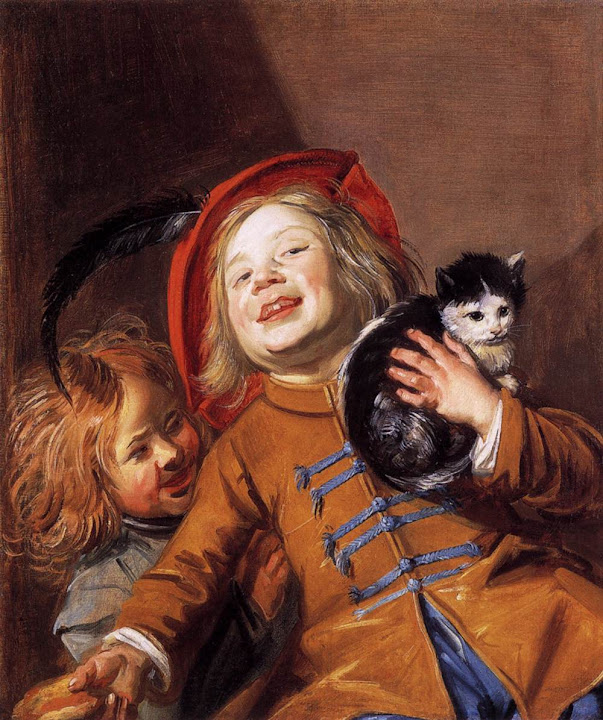 |
| 1629 Children with a Birdcage and a Cat by Eglon Hendrick van der Neer (1609-1660) oil on canvas 61 x 52 cm Noortman, Maastricht, Netherlands |
Eglon van der Neer was a Dutch painter of historical scenes, portraits and elegant, fashionable people, and later of landscapes. Van der Neer was born in Amsterdam and was probably first taught by his father, Aert van der Neer, who married in Amsterdam in 1629, coming from Gorinchem. Eglon took lessons from Jacob van Loo, who was then one of the foremost figure painters in Amsterdam.
 |
| 1633-67 Barber Shop with Monkeys and Cats by Abraham Teniers (1629-1670) oil on copper 24 x 31 cm Kunsthistorisches Museum, Vienna |
Abraham Teniers was a Flemish painter and engraver who specialised in genre paintings of villages, inns and monkey scenes. He was a member of artist family Teniers which came to prominence in the 17th century. He was also active as a publisher.
 |
| 1635 Portrait of a Man with a Cat by Frans Hals (1580-1666c) oil on canvas 45.5 x 43 cm Gëmaldegalerie Alte Meisster, Kassel, Germany |
Frans Hals was born in Antwerp, but worked for most of his life in Haarlem. He is best known for portraits of the citizens of Haarlem, to which he brought an incisive characterisation and an unparalleled sense of animation. He also painted group portraits, depicting family groups, members of the civic guard and regents of Haarlem almshouses. These are generally regarded as his masterpieces.
Between 1601 and 1603 Hals was apprenticed to Karel van Mander, the artist, biographer and art theorist. In 1610, Hals matriculated in the painters' guild of Haarlem. It is thought that he met Rubens who visited the city in 1624. The rapidity of Hals's technique and his incisiveness can be contrasted with the studied fluidity of Rubens's works.
The type of genre scenes in which Hals specialised, many of them depicting children, inspired a number of local painters, including his pupil Judith Leyster. Much later, the dazzling virtuosity of his brushwork became an important precedent for the achievements of the 19th-century French artist, Edouard Manet.
 |
| c1670 The Chess Players by Cornelis de Man (1621-1706) oil on canvas 38 x 33 cm Museum of Fine Arts, Budapest, Hungary |
Cornelis de Man was almost forgotten until 1903, when art historian Hofstede de Groot rediscovered his work. Little is known of his life. He may have been from a family of jewelers; he was certainly related to the clergy, which automatically would have elevated him to a social class both feared and highly esteemed. In 1642 de Man was received into the Delft's Guild of Saint Luke. He then traveled in France and Italy for nine years, working in Paris, Florence, Rome, and Venice. He returned to Delft in 1654, where he remained until his death. De Man was a pillar of the community and served repeatedly as regent of the guild. De Man is best known for his interior scenes of bourgeois families, which show the influence of Jan Vermeer and Pieter de Hooch, but he also painted Italianate and naturalistic Dutch landscapes and church interiors. In addition, he painted and occasionally etched portraits. His sitters were usually clerics and scholars, whom he depicted soberly, coldly, and correctly, often in professional settings. To compensate for their lack of facial expression, de Man painted emotive, "speaking" hands. His earliest genre pictures date from around 1658.
In 1642 de Man was received into the Delft's Guild of Saint Luke. He then traveled in France and Italy for nine years, working in Paris, Florence, Rome, and Venice. He returned to Delft in 1654, where he remained until his death. De Man was a pillar of the community and served repeatedly as regent of the guild. De Man is best known for his interior scenes of bourgeois families, which show the influence of Jan Vermeer and Pieter de Hooch, but he also painted Italianate and naturalistic Dutch landscapes and church interiors. In addition, he painted and occasionally etched portraits. His sitters were usually clerics and scholars, whom he depicted soberly, coldly, and correctly, often in professional settings. To compensate for their lack of facial expression, de Man painted emotive, "speaking" hands. His earliest genre pictures date from around 1658.
 |
| 1680 Children with a Birdcage and a Cat by Eglon Hendrick van der Neer (1834c-1703) oil on wood panel 24 x 19 cm The State Hermitage Museum, St. Petersburg |
Eglon Hendrik van Der Need was born in Amsterdam, the son of Aert van der Neer, who taught him. He was also a pupil of Jacob van Loo. He worked chiefly in Amsterdam. From 1679 to 1689 he was in Brussels. In 1690 he became court painter to the Elector Palatine in Düsseldorf, where he lived for the rest of his life.
 |
| c1700 A Glaring of cats making music and singing (Flemish School) oil on panel 49.5 x 25.6 cm |
 |
| c1700 Cats being instructed In the art of mouse-catching by an owl oil on canvas 83.5 x 110.5 |
 |
| 1700s (18th century) Black Cat hanging scroll: ink on paper 78.5 x 38.5 cm Princeton University Art Museum, NJ |
 |
| 1743 A Girl with a Kitten probably by Jean-Baptiste Perronneau (1715/16-1783) pastel on blue paper laid down on canvas 59.1 x 49.8 cm The National Gallery, London |
Although it bears the artist’s signature and the date 1745, some have questioned whether A Girl with a Kitten is indeed by Perronneau. The pigments in the pastels, the canvas and the paper are all consistent with a work produced in the eighteenth century. However, given that Perronneau had in 1734 won the first prize for drawing after the model at the Académie, it is difficult to explain the poor draughtsmanship of this work at this stage of his career.
The face is drawn with the stump of the pastel and not with its point, as was usual for the artist; the picture lacks the usual white highlights found on the face in Perronneau’s other pastel portraits; there is no bone structure to the head or the chest and the anatomy is poorly drawn. The picture’s most obvious weakness is its blandness – the sitter lacks the sense of real presence in a typical pastel portrait by Perronneau.The signature on the portrait is dubious when compared to Perronneau’s signature on his other works, and the date would make this his earliest-known dated pastel. Indeed, but for the ‘signature’, this picture might never have been attributed to Perronneau, so untypical is it overall of his style.
 |
| 1747 Mme Pinceloup de la Grange holding a Cat probably by Jean-Baptiste Perronneau (1715 Paris-1783 Amsterdam) oil on canvas 63.5 x 52 cm |
Jean-Baptiste Perronneau was, after Maurice-Quentin de la Tour, his older contemporary, the most famous specialist of portraiture in pastel in 18th-century France. The use of pastel as a medium had become fashionable in Paris after the visit of the Venetian artist Rosalba Carriera in 1719-20.
Perronneau was born in Paris and is thought to have been trained by Charles-Joseph Natoire and by the engraver Laurent Cars. He began his career as an engraver before turning to portraiture, in oil as well as in pastel. He became a member of the Academy in 1753. In France Perronneau was less successful than La Tour, who portrayed most of the leading figures of the age. Perronneau spent a wandering life, which took him to Italy in 1759, to Russia in 1781 and frequently to Amsterdam, where he died.
1761c White Angora Cat by Jean-Jacques Bachelier
Jean-Jacques Bachelier was a French painter and director of the porcelain factory at Sèvres.
Admitted to the Académie Royale de Peinture et de Sculpture in 1752, he founded an art school using his own means in Paris in 1765 for the artisans in the historic collège d'Autun, which survived until the 19th century.
He was in effect the inventor of unglazed biscuit porcelain, which he was the first to use as a final product, in 1751 at Sèvres. Previously this material was no more than a first stage in the porcelain manufacturing process.
 |
| c1750 Portrait of the Cat Armellino with a Sonnet by Bertazzi oil on canvas 76 x 62.5 cm Museo di Roma, Italy |
 |
| c1761 White Angora Cat by Jean-Jacques Bachelier (1724-1806) 66 x 81 cm Photo © RMN-Grand Palais |
 |
| before 1767 Girl with a Cat by Giacomo Ceruti (1698 – 1767) |
Giacomo Antonio Melchiorre Ceruti was an Italian late Baroque painter, active in Northern Italy in Milan, Brescia, and Venice. He acquired the nickname Pitocchetto (the little beggar) for his many paintings of peasants dressed in rags.
While he also painted still-life paintings and religious scenes, Ceruti is best known for his genre paintings, especially of beggars and the poor, whom he painted realistically and endowed with unusual dignity and individuality.
 |
| 1768-70 Two Girls dressing a Kitten by Candleight by Joseph Wright of Derby (1734-1797) oil on canvas 79 x 61 cm Kenwood House, London |
Joseph Wright ARA, styled Joseph Wright of Derby, was an English landscape and portrait painter. He has been acclaimed as "the first professional painter to express the spirit of the Industrial Revolution.”
Wright is notable for his use of tenbrism effect, which emphasises the contrast of light and dark, and for his paintings of candle-lit subjects. His paintings of the birth of science out of alchemy, often based on the meetings of the Lunar Society of Birmingham, a group of scientists and industrialists living in the English Midlands, are a significant record of the struggle of science against religious values in the period known as the Age of Enlightenment.
Note: A series on the works of Joseph Wright of Derby can be found in the index of this blog.
 |
| c1780 Sophia Dumergue by Johann Zoffany oil on panel 76 x 61.5 cm Victoria Art Gallery, Bath, UK |
An Anglo-German artist, Zoffany was one of the first Royal Academicians, nominated by his friend and patron King George III. Zoffany, however, was no stranger to scandal, and by his forties his daring work had seen him ousted from the King’s favour. Zoffany was born near Frankfurt in 1733, the son of a master craftsman who served at Prince Karl Anselm’s court in Regensburg. At the age of 17 he resolved to train as an artist and set off for Rome, where he studied with the artist and theorist Anton Raphael Mengs. Zoffany spent several years travelling around Europe painting for various aristocrats, princes and kings, before arriving in London in 1760.
Zoffany initially struggled to establish himself in the upper echelons of society, hindered by the fact that he never became fluent in English. Ultimately two significant patrons secured his financial and commercial success: the actor and playwright David Garrick, and Queen Charlotte. For Garrick, he painted theatrical scenes and portraits that were engraved and turned into prints, helping to popularise his work among the British public. From the mid-1760s to late 1770s, Zoffany also enjoyed royal patronage, completing portraits including Queen Charlotte with her two Eldest Sons and George III, Queen Charlotte and their six eldest children.
 |
| c 1780s Le Chat Angora by Marguerite Gérard (1761-1806) and Jean-Honore Fragonard (1732-1806) oil on canvas 65 x 53.5 cm Bernheimer Fine Old Masters Kunsthandel, Munich |
Gérard, who never married and apparently never demonstrated any interest in joining the Academy, had a tremendously successful career. She won three medals for her work, which she exhibited regularly once the Salons were opened to women in the 1790s. Her pictures were acquired by luminaries such as Napoleon and King Louis XVII, and she acquired considerable wealth and real estate.
Her interest in art was shaped by her brother-in-law, the popular Rococo painter Jean-Honoré Fragonard, beginning in 1775, when she moved from Grasse to Paris to live with her sister’s family. As part of the Fragonard household, Gérard had considerable financial freedom, along with the opportunity to further her artistic training as her brother-in-law’s unofficial apprentice.
By her mid-20s, Gérard had developed her signature style, which featured painstakingly accurate details rendered with subtly blended brush strokes, both traits borrowed from 17th-century Dutch genre specialists, notably Gabriel Metsu. Gérard’s work is technically impressive but also practical: these relatively small-scale, portable canvases appealed to wealthy collectors who preferred to display in their homes meticulously painted still lifes and genre scenes rather than large history paintings. The numerous engraved versions of Gérard’s paintings made them accessible to less affluent art lovers and helped increase her reputation.
Jean-Honoré Fragonard was born at Grasse, in the south of France. He trained in Paris with Chardin and then Boucher. In 1752 he won the Prix de Rome, and then entered the royal school of Elèves Protégés, directed by Carle van Loo. He was at the French Academy in Rome from 1756 to 1761.
After his return to France, Fragonard was initially successful as a painter of decorative schemes. He received a setback when his now-famous series, 'The Progress of Love' of 1771 (New York, Frick Collection), commissioned by Madame du Barry, the last mistress of Louis XV, was refused in preference to classicising scenes by Marie-Joseph Vien.
He paid a second visit to Italy in 1773-4, continuing on his return to paint landscapes, fanciful portraits and scenes of everyday life, as well as working as a book illustrator. From the mid-1780s his style, while retaining its dynamism, became more Neo-classical. Between 1793 and 1800 he was heavily involved in arts administration.
 |
| 1800 Beauties After a Bath by Kitagawa Utamaro (1753c - 1806) woodblock print |
Kitagawa Utamaro was a Japanese artist. He is one of the most highly regarded designers of ukiyo-e woodblock prints and paintings, and is best known for his bijin okubi-e "large-headed pictures of beautiful women" of the 1790s. He also produced nature studies, particularly illustrated books of insects.
Little is known of Utamaro's life. His work began to appear in the 1770s, and he rose to prominence in the early 1790s with his portraits of beauties with exaggerated, elongated features. He produced over 2000 known prints and was one of the few ukiyo-e artists to achieve fame throughout Japan in his lifetime. In 1804 he was arrested and manacled for fifty days for making illegal prints depicting the 16th-century military ruler Toyotomi Hideyoshi, and died two years later.
Utamaro's work reached Europe in the mid-nineteenth century, where it was very popular, enjoying particular acclaim in France. He influenced the European Impressionists, particularly with his use of partial views and his emphasis on light and shade, which they imitated. The reference to the "Japanese influence" among these artists often refers to the work of Utamaro.
 |
| c1800 A Woman and a Cat by Kitagawa Utamaro |
 |
| 1800s (19th century) Black Cat and Narcissus hanging scroll; ink and colour on paper 93.7 x 36.8 cm Metropolitan Museum of Art, New York City |
 |
| 1802 Cat on a blanket by Jean Bernard Duvivier (1775-1833) graphite? |
Jean-Bernard Duvivier, born in Bruges, Belgium, was a painter and illustrator of portraits and historical and religious subjects, a book illustrator and a professor at the Normal School in Paris. After having been instructed by Hubert and Paul de Cock and Suvée, he studied in Italy for six years. His style is characterised by balanced composition, life-like drawing and bright colours.
 |
| c1810-12 Head of a Cat by Sir Edwin Landseer RA (1802 - 1873) pencil on cream wove paper 4.5 x 5.7 cm Royal Academy of Arts, London |
Sir Edwin Henry Landseer was an English artist best known for his animal paintings and sculptures. Landseer’s popularity in Victorian Britain was considerable, and his reputation as an animal painter was unrivalled. He is particularly associated with Scotland, which he first visited in 1824, and you will see that many of his works are of Scottish subjects. In 1858 the government commissioned Landseer to make four (now famous) bronze lions for the base of Nelson’s Column in Trafalgar Square. Edwin Landseer died in October 1873, and his death was widely marked in England. He was buried in St. Paul’s Cathedral, London.
Note: A series on the works of Edwin Landseer can be found in the index of this blog.
 |
| c1810 Portrait of Franz Pforr by Johann Friedrich Overbeck (1789-1869) oil on canvas 62 x 47 cm Nationalgalerie, Berlin |
Overbeck was a romantic painter of Christian religious subjects, who was leader of a group of German artists known as the Nazarines, or Lucas Brotherhood (Lukasbund). In 1806 Overbeck entered the Academy of Vienna, where, disappointed in the academic approach to teaching, he and Franz Pforr in 1809 founded the Lucas Brotherhood. They sought to revive the medieval artists’ guilds and to renew the arts through Christian faith (in 1813 Overbeck joined the Roman Catholic Church). For artistic inspiration they turned to Albrecht Dürer and to Italian Renaissance art, particularly the works of Perugino and early Raphael.
As he advanced in years, Overbeck’s painting became pallid and stereotyped, Yet these late works greatly influenced Christian devotional art of the 19th century and the paintings of the Pre-Raphaelite Brotherhood. His more vital early pictures and drawings, however, were rediscovered and appreciated early in the 20th century.
 |
| 1812 Cat and Bowl by Jean Bernard Duvivier (1775-1833) |
 |
| 1813 Cat by Jean Bernard Duvivier (1775-1833) crayon |
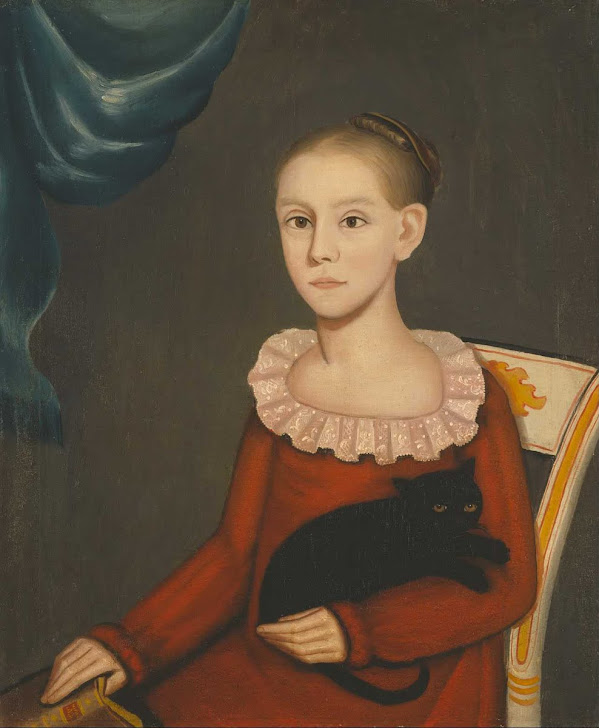 |
| c1814 Girl with Cat by Ammi Phillips (1788-1865) oil on canvas 63.5 x 76.2 cm Amon Carter Museum of American Art, Fort Worth, Texas |
Ammi Phillips (April 24, 1788 – July 11, 1865) was a prolific American itinerant portrait painter active from the mid 1810s to the early 1860s in Connecticut, Massachusetts, and New York. His artwork is identified as folk art, primitive art, provincial art, and itinerant art without consensus among scholars, pointing to the enigmatic nature of his work and life. He is attributed to over eight hundred paintings, although only eleven are signed.
 |
| 1818 Cat by Jean Bernard Duvivier (1775-1833) crayon |
 |
| 1819 Cat by Jean Bernard Duvivier (1775-1833) charcoal and coloured crayons |
 |
| 1821 The Dead Cat by Théodore Géricault (1791-1824) oil on canvas oil on canvas 50 x 61 cm Musée du Louvre, Paris |
Géricault is now identified as a pioneer of Romanticism in French painting. He loved horses, and dramatic images of rearing horses feature in his work. He was born at Rouen, and from 1808 trained in Paris with Carle Vernet. But after two years he left Vernet - saying 'One of my horses would have devoured six of his' - to go to the Neo-classical painter Pierre Guérin, with whom his friend Delacroix later studied.
Géricault was influenced by the military subjects of Baron Gros and by works in the Louvre, notably those by Rubens and Renaissance Venetian painters. A visit to Italy in 1816-7 intensified Géricault's appreciation of Micelangelo. On his return to Paris he painted his most famous work, 'The Raft of the Medusa' (Paris, The Louvre), a scene of modern drama on a vast scale and executed in the heroic manner, which he exhibited at the Salon of 1819.
An admirer of English art, like Delacroix, he visited England in 1820-1, returning in a state of poor health. From his last years date an exceptional series of portraits, commissioned by a friend, of the inmates of a lunatic asylum.
 |
| 1825 Curled up, sleeping Cat by Jean Bernard Duvivier (1775-1833) graphite on paper 18.7 x 28 cm Rijksmuseum, Amsterdam |
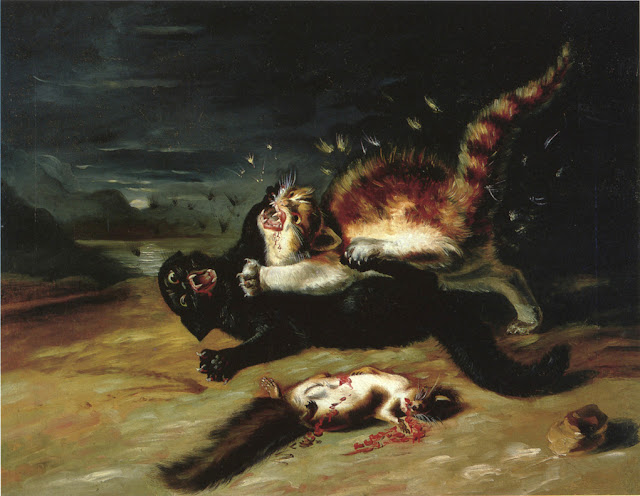 |
| 1826 Two Cats Fighting by John James Audubon (1785-1851) oil on canvas 71.2 x 92.1 cm |
John James Audubon was an American ornithologist, naturalist, and painter. His combined interests in art and ornithology turned into a plan to make a complete pictorial record of all the bird species of North America. He was notable for his extensive studies documenting all types of American birds and for his detailed illustrations, which depicted the birds in their natural habitats. His major work, a colour-plate book titled The Birds of America (1827–1839), is considered one of the finest ornithological works ever completed. Audubon is also known for identifying 25 new species. He is the eponym of the National Audubon Society, and his name adorns a large number of towns, neighbourhoods, and streets in every part of the United States. Dozens of scientific names first published by Audubon are currently in use by the scientific community,
 |
| 1830-35 Girl in Red Dress with Cat and Dog by Ammi Phillips (1788-1865) oil on canvas 76.2 x 63.5 cm American Folk Art Museum, New York |
 |
| 1830-35 Portrait of a young Girl and her Cat by Ammi Phillips (1788-1865) oil on canvas 91.4 x 71.1 cm |
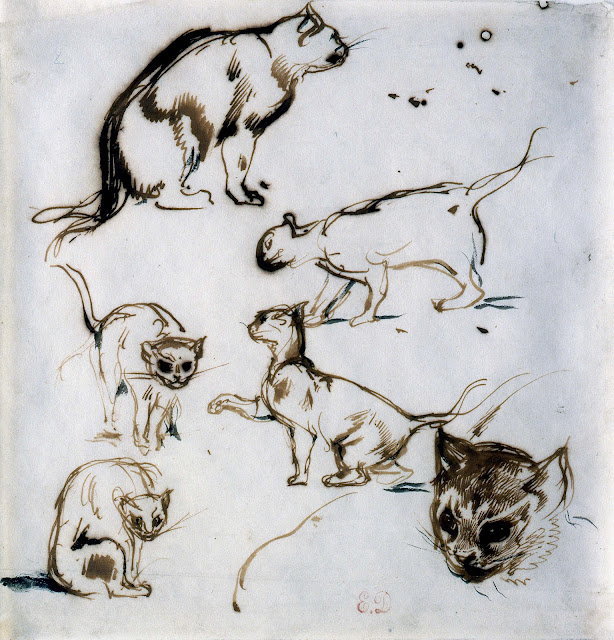 |
| c 1830s Six Studies of Cats by Eugène Delacroix (1798-1863) brown ink on vellum 18.8 x 18 cm © MuMa Le Havre - Charles Maslard |
Delacroix was the leading exponent of Romanticism in French painting. He was trained by the Neo-classical painter Pierre Guérin, from 1816 to about 1823. Guérin also taught Géricault.
Delacroix first exhibited at the Salon in 1822. In style his work shows the influence of painters he had studied, notably Rubens. He was an admirer of English painting, and visited England in 1825. In 1832 he travelled to Spain, Morocco and Algiers. After the Revolution of 1830 he was favoured by Louis-Philippe, and later by Napoleon III, with a long series of official commissions, beginning in 1833 with a series of decorations in the Palais Bourbon.
 |
| c 1830s Study of the head of a cat by Eugène Delacroix (1798-1863) 28.1 x 30.4 cm The British Museum, London |
 |
| 1830s Studies of a Cat by Eugène Delacroix (1798-1863) pen and brown ink and wash on laid paper 19 x 28.2 cm The Morgan Library & Museum, New York City |
 |
| before 1837 La Dame avec son Chat by Marguerite Gérard (1761-1837) oil on canvas Private Collection |
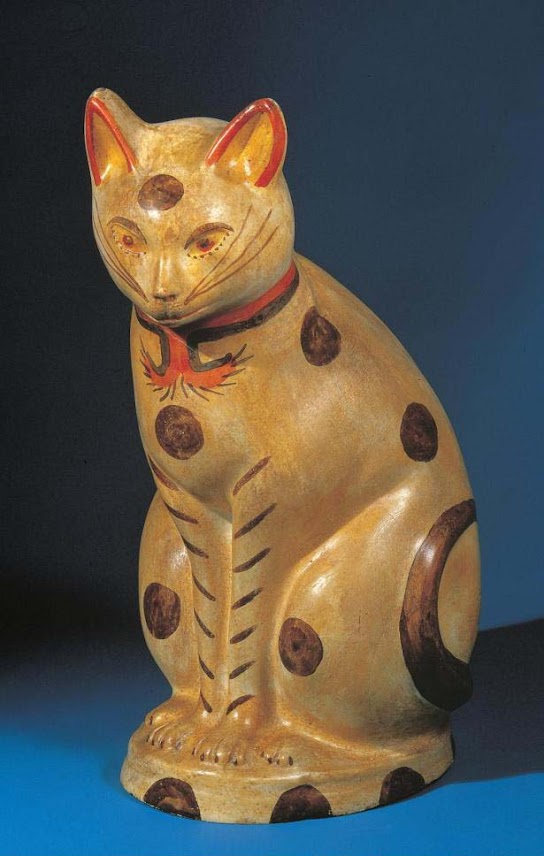 |
| 1850-1900 Seated Cat Chalkware (paint on plaster of Paris) 39.7 x 22.2 x 25.7 cm American Folk Art Museum, New York City |
Three-dimensional images cast of calcined gypsum, known today as chalkware, were produced in America as early as 1768, when stonecutter Henry Christian Geyer advertised plaster of Paris busts of famous public figures as well as “Animals such as Parrots, Cats, Dogs, Lions, Sheep, with a number of others too many to enumerate.” By the middle of the nineteenth century, chalkware provided an inexpensive alternative to imported ornaments fashioned from porcelain, earthenware, and other materials for the rural consumers hungry for decorative objects for their homes.
 |
| 1852 Woman holding a Cat by Utagawa Kuniyoshi (1797-1861) coloured xylograph 36.7 x 24.8 cm |
Utagawa Kuniyoshi is one of the great ukiyo-e woodblock print masters of the late Edo period in the 19th century, renowned for dynamic and often violent prints of monsters, demons, ghosts, and samurai heroes. As a member of the Utagawa school, Kuniyoshi gained renown for his “warrior prints,” or musha-e, a genre that is widely credited as a significant influence on modern-day manga comics. His breakthrough series The 108 Heroes of the Popular Suikoden, based on the 14th-century Chinese novel of the same name, catapulted Kuniyoshi to fame in 1827. Kuniyoshi worked across many pictorial genres during his career. His broad range of subjects included landscapes, courtesans, Kabuki actors, cats, and mythical animals. Kuniyoshi’s works can be found in international institutions, and his woodblock prints continue to serve as a source of inspiration for contemporary tattoo artists.
 |
| 1855-56 Woman churning Butter by Jean-François Millet (1814-1875) etching 17.9 x 11.8 cm The Metropolitan Museum of Art, New York |
Millet was born at Grouchy (Manche) and was a pupil of Paul Delaroche in Paris by 1837. For some years he painted chiefly idylls in imitation of 18th-century French painters. Becoming, like Honoré Daumier, increasingly moved by the spectacle of social injustice, Millet turned to peasant subjects and won his first popular success at the Salon of 1848 with 'The Winnower'. From the following year he was chiefly active at Barbizon and associated with the Barbican school of landscape painters.
His work was influenced by Dutch paintings of the 17th century and by the work of Jean-Siméon Chardin, and was influential in Holland on Jozef Israëls and on the early style of Vincent Van Gogh.
 |
| 1856 Puss Napping by George Baxter (1804-1867) print (Baxter Process) 10.9 x 15.3 cm The British Museum, London |
George Baxter (1804–1867) was an English artist and printer based in London. He is credited with the invention of commercially viable colour printing.Though colour printing had been developed in China centuries before, it was not commercially viable. However, in early years of the 19th century the process of colour printing had been revived by George Savage, a Yorkshireman in London. It was to be Savage's methods upon which Baxter, already an accomplished artist and engraver, was to improve. In 1828, Baxter began experimenting with colour printing by means of woodblocks.
 |
| before 1859 Girl in Orange Dress with Cat by William Thompson Bartoll (1817-1859) |
William Thompson Bartoll was the son of John and Rebecca Bartoll and was baptized in Marblehead, Massachusetts on June 22, 1817. He married Sally L. Selman in April of 1835. Bartoll, like his father, uncle and brother, was a house painter, as well as a portraitist and mural painter. He is known to have exhibited at the Boston Athenaeum between 1841 and 1855 and he died in 1859 in Marblehead.
 |
| 1860-78 Kitten's Game by Henriëtte Ronner-Knip (1821-1909) oil on panel 32.8 x 45.2 cm Rijksmuseum, Amsterdam |
Henriëtte Ronner-Knip was a Dutch-Belgian artist in the Romantic style who is best known for her animal paintings; especially cats, was born in Amsterdam into a family of artists and received her first lessons from her father, Joseph August Knip. Some sources indicate that her mother was Pauline Rifer de Courcelles, a painter of birds, who was her father's first wife but, at the time of her birth, they were apparently separated and he was living with his mistress, Cornelia van Leeuwen (1790–1848), who is also credited with being Henriëtte's mother.


No comments:
Post a Comment
Note: only a member of this blog may post a comment.